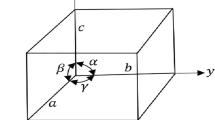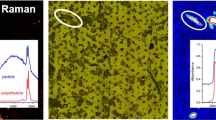Abstract
An ultra-miniaturised (mass 1.5 kg; volume ~22 × 6 × 12 cm3) instrument which combines X-ray diffraction and fluorescence has been developed for the mineralogical and chemical characterization of Martian soils/rocks and was included in the ExoMars-Pasteur payload. The simultaneous in situ acquisition of elemental and mineralogical information would significantly improve any robotic missions and may unravel doubtful points regarding the mantle composition, crustal evolution and resource potential. The instrument employs a fixed reflection geometry to fulfil the diffraction principle which can be applied to unprepared sample as well. The instrument basically consists of a radioisotope as source of X-rays and a CCD-based detection system. This is the first successful diffraction experiment using a radioisotope since the early tests in the 60s. For terrestrial application the radioisotope can be easily replaced with a cathodic tube. The reduced dimension as well as the possibility to perform non-destructive analysis makes it suitable for terrestrial applications, particularly in the archaeometry field. We are envisaging an X-ray tomographer to map the mineralogical and elemental composition of an artefact (i.e., painting, pottery) directly on the object without sample preparation. Nowadays, X-ray radiography or computer tomography are becoming standard techniques widely used and accepted by art historians, archaeologists, curators and conservators as these methods enable information about the manufacturing process and the condition of an object without touching the artefact or even taking original sample material.







Similar content being viewed by others
References
Angel RJ, Mazzucchelli ML, Alvaro M, Nimis P, Nestola F (2014) Geobarometry from host-inclusion systems: the role of elastic relaxation. Am Miner 99:2146–2149
Angel RJ, Alvaro M, Nestola F, Mazzucchelli ML (2015) Diamond thermoelastic properties and implications for determining the pressure of formation of diamond inclusion systems. Russ Geol Geophys J 56(1–2):211–220
Applbaum N, Applbaum YH (2005) The use of medical computed tomography (CT) imaging in the study of ceramic and clay archaeological artifacts from the ancient near east. In: Uda M, Demortier G, Nakai I (eds) X-rays for archaeology. Springer, Netherlands, pp 231–246
Bish D, Blake D, Vaniman D et al (2014) The first X-ray diffraction measurements on Mars. IUCrJ 1:514–522
Blake D, Vaniman D, Achilles C et al (2012) Characterization and calibration of the CheMin mineralogical instrument on Mars science laboratory. Space Sci Rev 170:341–399
Bugenis C, Preuss LE, Toothacker WS (1968) Laboratory Debye-Scherrer camera using an 55Fe source of Mn Kα Xrays. Rev Sci Instrum 39:1754–1755
Marinangeli L, Hutchinson IB, Baliva A et al (2007) An european XRD/XRF instrument for the Exomars mission. In: Lunar and planetary science XXXVIII, Abstract #1322, Lunar and planetary institute, Houston (CD-ROM). http://www.lpi.usra.edu/meetings/lpsc2007/pdf/1322.pdf
Nakai I, Abe Y (2012) Portable X-ray powder diffractometer for the analysis of art and archaeological materials. Appl Phys A 106(2):279–293
Nestola F, Merli M, Nimis P et al (2012) In situ analysis of garnet inclusion in diamond using single-crystal X-ray diffraction and X-ray micro-tomography. Eur J Miner 24(4):599–606
Pelliciari C, Marinangeli L, Critani F, Baliva A, Hutchinson IB (2011) Optimization of the MARS-XRD collimator using converging blades. In: Hudec R, Pina L (eds) EUV and X-ray optics: synergy between laboratory and space II, Proceedings of SPIE, 8076, Cardif
Pifferi A, Campi G, Giacovazzo C, Gobbi E (2009) A new portable XRD/XRF instrument for non-destructive analysis. Croat Chem Acta 82(2):449–454
Plescia P, Ingo GM (2005) Surface monitor: a new instrument for in situ XRD-XRF and optical measurements. In: Denver X-ray conference abstract, Denver
Preuss LE, Toothacker WS, Bugenis CK (1966) Demonstration of X-ray diffraction by LiF using the Mn Kα X-rays resulting from 55Fe decay. Appl Phys Lett 9:159–161
Preuss LE, Toothacker WS, Bugenis CK (1967) Single-crystal X-ray diffraction using photons from two radioactive isotopic sources. J Appl Phys 38:3404–3405
Tarquini O, Colapietro M, Belelli Marchesini B, Pardini G (2012) X-Ray imaging, X-Ray fluorescence and diffraction to study metal archaeological remains from excavations. In: Vezzalini G, Zannini P (eds) Atti del VII Convegno Nazionale di Archeometria-A.I.Ar. Patron Editore, Bologna
Vago J, Witasse O, Baglioni P, Haldemann A, Gianfiglio G, Blancquaert T, McCoy D, de Groot R et al (2013) ExoMars: ESA’s next step in Mars exploration. Eur Space Agency Bull 155:12–23
Vaniman DT, Bish DL, Ming DW et al (2014) Mineralogy of a mudstone at Yellowknife Bay, Gale Crater. Mars Sci 343:6169
Acknowledgements
This work has been supported by the Italian Space Agency (ASI) under the contract I/060/10/0. We wish to thank an anonymous reviewer and Mihaela Glamoclija for the detailed and helpful comments. We are grateful to Dott. Fabio Critani for the software development of the prototype.
Author information
Authors and Affiliations
Corresponding author
Additional information
This contribution deals with topics considered in the session, “Archaeometry and cultural heritage: the contribution of geosciences” held during the conference “The future of the Italian geosciences, the Italian geosciences of the future”, organized by the Società Geologica Italiana and the Società Italiana di Mineralogia e Petrologia, Milano, 10–12 Sept, 2014.
Rights and permissions
About this article
Cite this article
Marinangeli, L., Pompilio, L., Baliva, A. et al. Development of an ultra-miniaturised XRD/XRF instrument for the in situ mineralogical and chemical analysis of planetary soils and rocks: implication for archaeometry. Rend. Fis. Acc. Lincei 26, 529–537 (2015). https://doi.org/10.1007/s12210-015-0477-3
Received:
Accepted:
Published:
Issue Date:
DOI: https://doi.org/10.1007/s12210-015-0477-3




